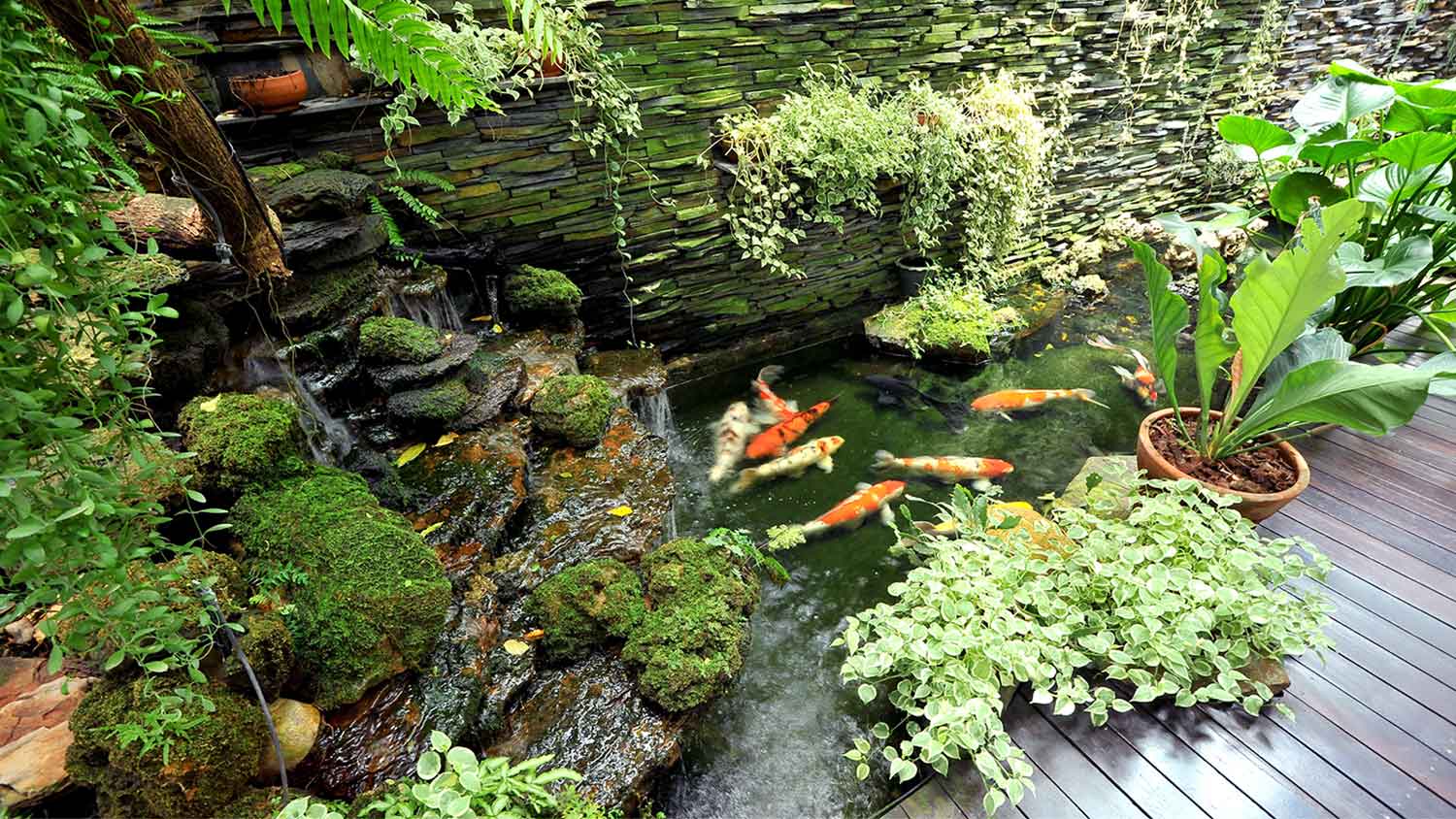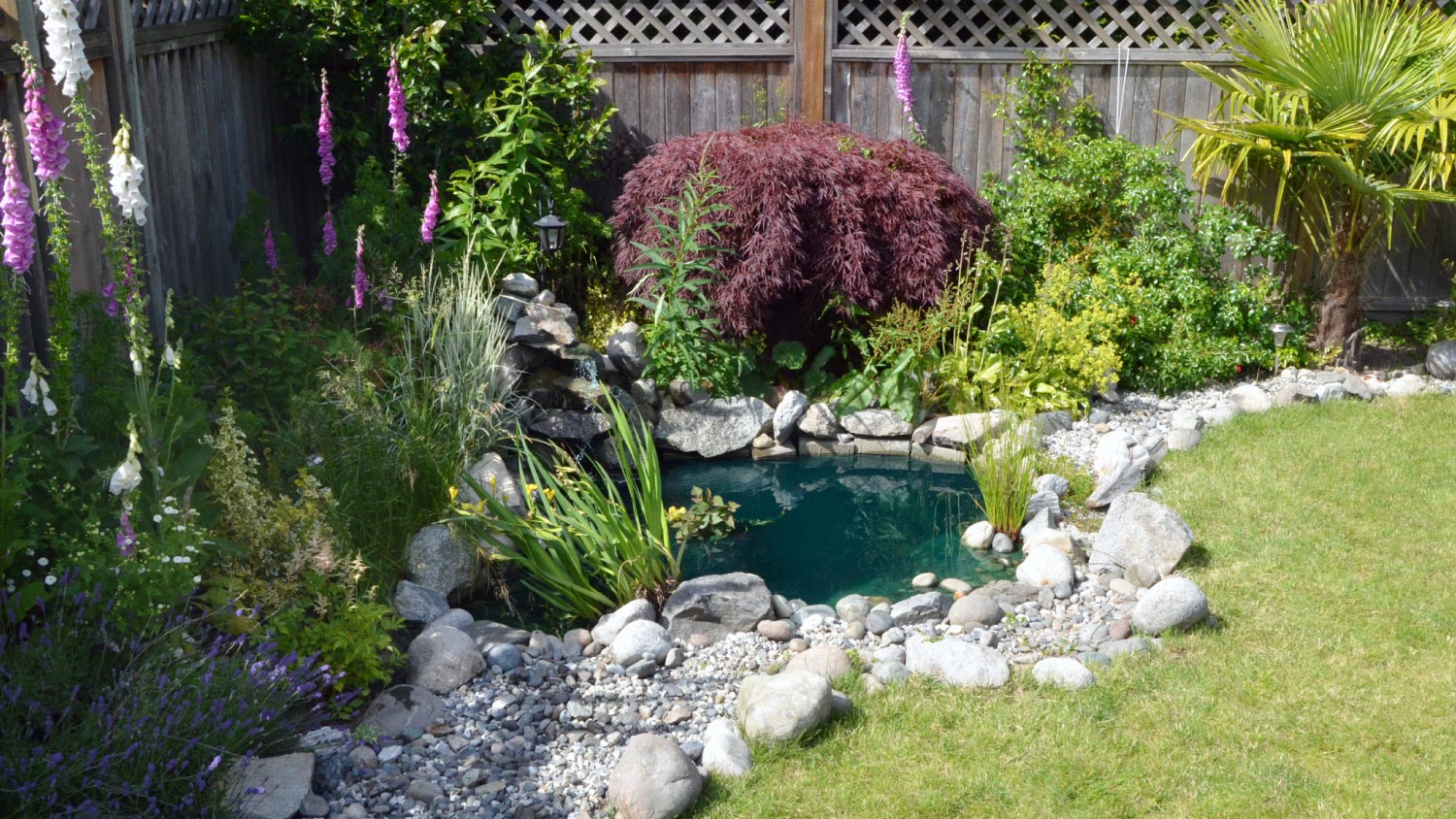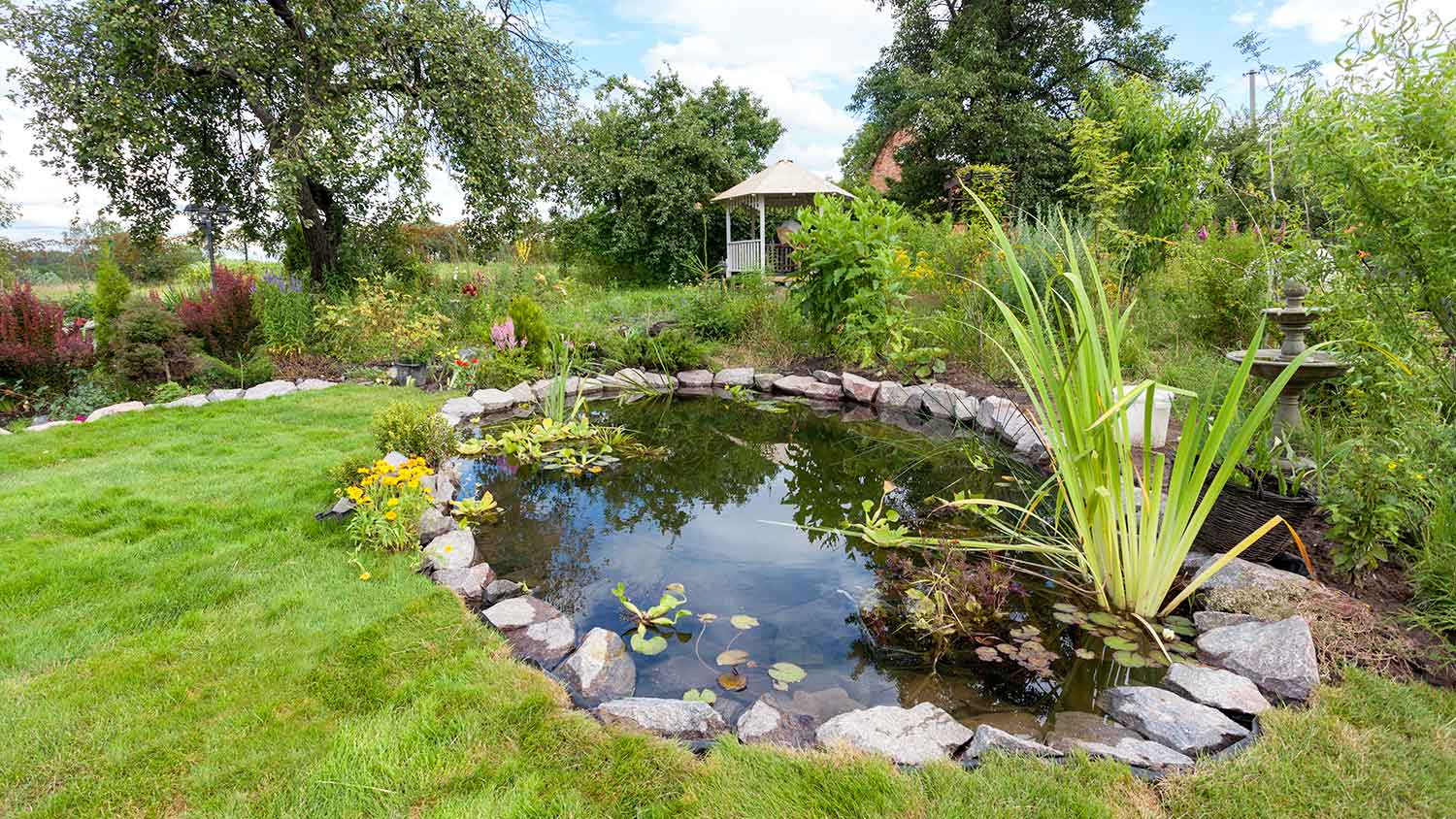
Wondering how much it costs to build a koi pond? Discover prices, cost factors, and tips to plan your dream backyard pond.
Fountain service costs depend on your project and location. Check with a local pro for your specific job.
Pond size and fish species are the biggest cost drivers.
Professional stocking ensures healthy fish populations and compliance.
Ongoing maintenance contributes to long-term costs, with fees ranging from $50 to $150 per visit.
Permits and local regulations may impact your total investment.
Stocking a pond can boost property value and recreational enjoyment.
This article was created using automation technology and thoroughly fact-checked and edited by an Angi Editor in accordance with our AI policy.
Most homeowners spend $1,500 to $5,000, with costs ranging from $800 for small ponds to $7,500 or more for larger or specialty projects. Prices vary based on pond size, fish type, and professional services. Stocking costs are calculated on a per-acre or per-fish basis.
A well-stocked pond can provide recreation, beauty, and even increase your property’s value. In this guide, we’ll walk you through every cost factor, so you can plan your pond stocking project with confidence.
When considering how much it costs to stock a pond, it’s important to look at several main factors: the type of pond and its intended use, the size of your pond, the fish species and materials you select, and the hatchery or supplier brand. Each factor can significantly change your total investment.
The purpose of your pond has a big impact on stocking costs. Recreational fishing ponds, decorative koi ponds, and wildlife habitat ponds all have different needs. For example, a fishing pond will require more fish and careful species selection to create a balanced ecosystem, whereas a decorative pond might focus on fewer, more expensive fish, such as koi.
Stocking a single species is less expensive than creating a diverse, multi-species ecosystem. However, multi-species ponds often require careful planning of predator and prey ratios to ensure fish survival and growth, which can increase costs. Maintaining this balance supports long-term pond health and minimizes losses from predation or competition.
| Stocking Type | Description | Average Cost Range |
|---|---|---|
| Recreational fishing | Stocked for bass, bluegill, and catfish, balanced for fishing | $1,000–$5,000 |
| Decorative | Ornamental species like koi or goldfish often have lower densities | $800–$6,000 |
| Wildlife habitat | Supports frogs, turtles, waterfowl, and mixed native fish | $900–$4,500 |
| Multi-species | Several fish types for ecosystem balance and predator-prey mix | $1,200–$7,500 |
| Single-species | One type of fish, easier management, less balance needed | $800–$3,000 |
Pond size is a primary factor in determining the cost. Larger surface areas and greater depths require more fish, resulting in higher expenses. Most pond stocking companies charge per acre for larger ponds, or per 1,000 gallons for smaller decorative or backyard ponds. The recommended stocking density depends on the pond’s purpose and its ability to support fish health.
A recreational fishing pond may need 500 to 1,000 fish per acre, while a decorative pond might support fewer, high-value fish. Small backyard ponds (under 5,000 gallons) can often be stocked for less, but costs increase with additional features or rare species.
| Pond Size | Description | Average Stocking Cost |
|---|---|---|
| 1/4 acre | Small fishing or decorative pond | $800–$2,000 |
| 1/2 acre | Medium backyard/farm pond | $1,500–$3,500 |
| 1 acre | Standard recreational or wildlife pond | $2,500–$5,000 |
| 5,000 gallons | Small backyard koi or goldfish pond | $800–$1,800 |
| 10,000 gallons | Larger decorative or multi-species pond | $1,500–$3,500 |
The fish species you choose has a major impact on cost. Common choices for fishing ponds include largemouth bass, bluegill, catfish, and perch, while koi and goldfish are popular for decorative ponds. Stocking fingerlings (young fish) is less expensive than buying mature fish, but fingerlings may take longer to establish a thriving population.
Beyond fish, you may need to budget for fish feed, habitat structures like brush or rock piles, aerators to maintain oxygen levels, and water quality treatments. Adding aquatic plants or supplemental habitat can support a balanced ecosystem and reduce future losses, but it adds to upfront costs.
Where you buy your fish matters. Hatcheries and suppliers vary in price, reputation, and the guarantees they offer. Premium hatcheries may charge more for disease-free certification and live delivery warranties, but these can reduce risk and save money in the long run. Some budget suppliers offer lower prices, but may not guarantee live delivery or offer health certifications.
When comparing brands, look for reviews, health guarantees, and delivery policies. Reliable suppliers often include acclimation instructions and offer support if you encounter issues after stocking.
Stocking a pond involves more than just buying fish. Labor, delivery, prep work, and optional services all play a role in your final bill.
Professional pond stocking services often involve hatchery staff, aquatic biologists, or pond management companies. Minimum service fees may range from $200 to $300, with labor rates varying from $50 to $150 per hour or offering flat rates for full-service stocking. Urban areas may see slightly higher rates due to increased demand or travel costs.
Professional services include fish delivery, acclimation, habitat installation, and water testing. These steps help ensure the survival of fish and maintain the long-term health of the pond.
Transporting live fish requires specialized equipment and careful timing. Delivery fees range from $100 to $500, depending on the distance from the hatchery and the size of your order. Remote or hard-to-access properties may face additional surcharges. Some suppliers offer free delivery for large orders or when services are bundled.
If your pond contains old fish populations, invasive species, or excess debris, you may need removal services before restocking. Haul-away or cleaning fees range from $150 to $600, depending on the pond’s condition and the amount of work involved. Cleaning and prepping your pond ensures a healthy environment for new fish.
Many companies offer add-on services to help your pond thrive. Popular options include:
Advanced water testing: $50 to $200
Habitat installation: $100 to $500
Aerator system setup: $500 to $2,000
Ongoing management plans, periodic fish health checks, and restocking services are available for an additional fee.
Beyond the initial stocking, there are a few more costs to keep in mind for the life of your pond.
Some hatcheries offer live delivery warranties or health guarantees for a small fee, often 5% to 10% of the fish order total. These warranties cover survival rates for the first 24 to 72 hours, as well as disease-free certification. Although this raises the upfront cost, it can provide peace of mind and save you money if there are losses soon after delivery.
Maintaining a healthy stocked pond is an ongoing investment. Plan for fish feed ($20 to $100 per month, depending on fish type and quantity), water quality treatments ($100 to $300 per year), and aeration system electricity ($10 to $30 per month). Operating costs may spike in the summer when feeding and aeration needs increase, and in winter if you need to supplement oxygen or provide additional feed.
Routine pond maintenance includes water testing, algae control, habitat upkeep, and predator management. Hiring a pond maintenance service costs $50 to $150 per visit, while DIY maintenance can be less expensive but requires more time. Most ponds also need periodic restocking every two to five years, which adds to long-term costs.
Common repairs include fixing pond liner leaks, repairing or replacing aerators and filtration systems, and restoring damaged habitat structures. Addressing fish kills, water quality issues, or removing invasive species can cost between $300 and $2,500, depending on the severity of the issue. In some cases, major repairs may require full or partial restocking of fish.
If you’re considering stocking your pond yourself, it’s important to weigh the pros and cons. DIY stocking can save on labor costs, but requires careful planning, ordering, acclimation, and habitat setup. You’ll need basic equipment, such as fish transport tanks and water test kits, as well as knowledge of local regulations.
The main risks of DIY stocking are higher fish mortality, regulatory non-compliance, and ecosystem imbalance. Without professional help, you may lose more fish or accidentally introduce incompatible species. For large, complex, or high-value ponds, it’s best to hire a local pond service company for the initial stocking to avoid costly mistakes and maximize long-term success.
Deciding whether to restock your pond or fully replace the fish population depends on several factors. If you’ve experienced high fish mortality, poor water quality, disease outbreaks, or invasive species, investing in complete pond replacement may be necessary. However, if your pond is healthy but fish populations are low, supplemental restocking is sufficient and more affordable.
Partial restocking costs less than full replacement, often 30% to 60% of the price. Always consider warranty options, fish health, and the long-term management plan for your pond when making this decision.
Looking to keep your pond stocking project within budget? Here are some practical ways to save:
Buy fish in bulk or as part of a stocking package.
Choose native or hardy fish species to reduce mortality.
Schedule stocking during hatchery sales or off-peak seasons.
Perform basic pond prep and maintenance yourself.
Compare multiple hatcheries and request bundled service quotes.
Home is the most important place on earth, which is why Angi has helped more than 150 million homeowners transform their houses into homes they adore. To help homeowners with their next project, Angi provides readers with the most accurate cost data and upholds strict editorial standards. We extensively research project costs to develop the pricing data you see, so you can make the best decisions for you and your home. We rely on reputable sources, including the U.S. Bureau of Labor Statistics, academic journals, market studies, and interviews with industry experts—all to ensure our prices reflect real-world projects.
Want to help us improve our cost data? Send us a recent project quote to [email protected]. Quotes and personal information will not be shared publicly.
From average costs to expert advice, get all the answers you need to get your job done.

Wondering how much it costs to build a koi pond? Discover prices, cost factors, and tips to plan your dream backyard pond.

Get a detailed breakdown of pond dredging costs, including average prices, cost factors, and tips to help homeowners budget for their pond maintenance project.

Maintaining your backyard pond keeps it clean and in good condition. Learn how much pond maintenance costs and what factors can affect the price.

A backyard oasis could be just a few steps away. Get koi pond ideas to inspire your own backyard water landscaping and answers to commonly asked questions.

Maintaining a koi pond is not for the faint of heart, but the rewards are worth it to keep your koi fish happy and healthy.

How much does a pond liner cost? Get detailed price breakdowns, installation factors, and tips to save on your pond liner project.